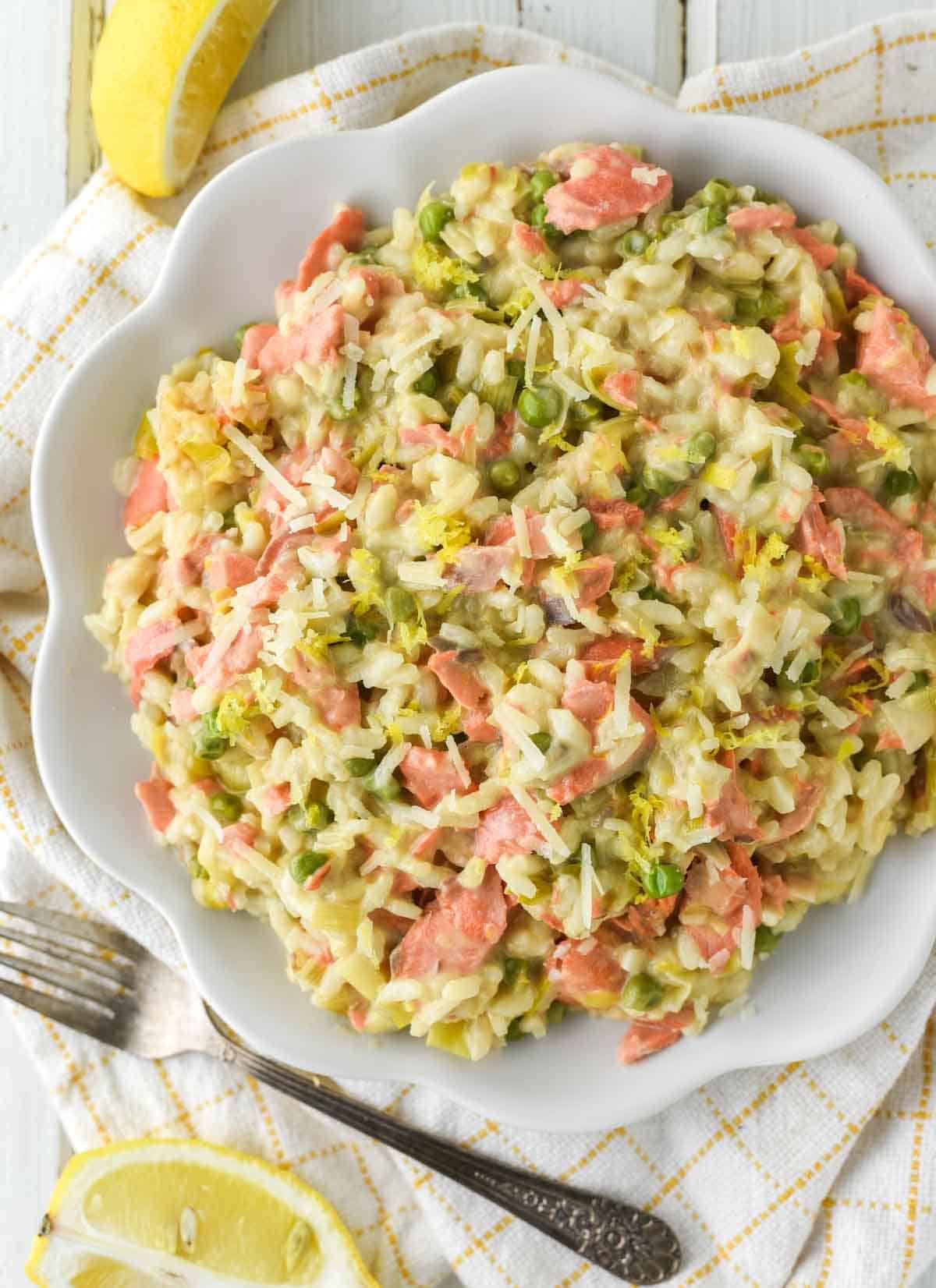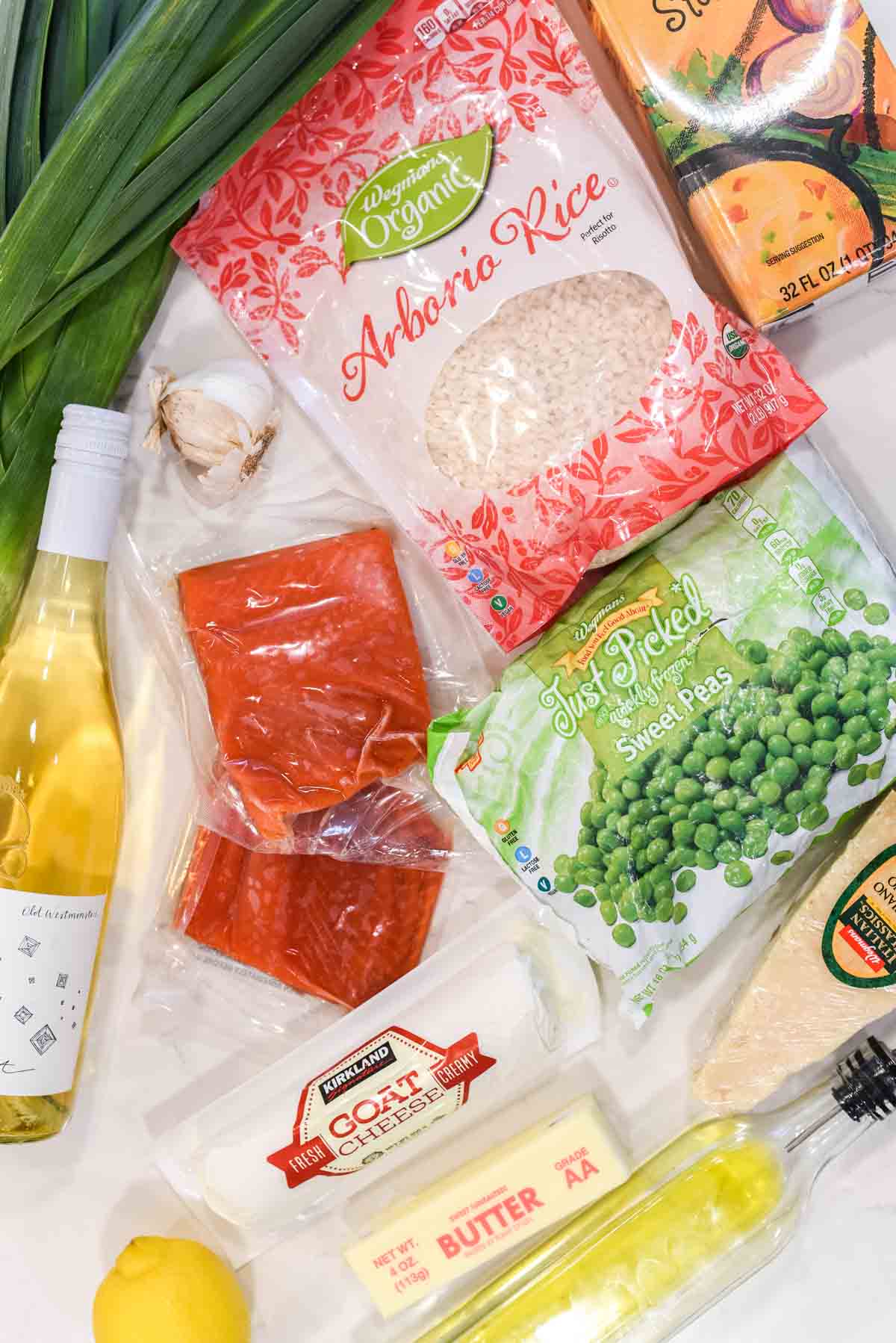This post may contain affiliate links. Please read my disclosure.
With succulent salmon, lemon and peas, this salmon risotto offers a creamy and rich flavor, making it perfect for any occasion.

When it comes to salmon, I'm always finding ways to use it for meals - from baked teriyaki salmon to pasta alla salmone to tandoori salmon.
But have you ever thought of incorporating it into risotto? When adding in leaks, peas, goat cheese and lemon, it creates a tasty all-in-one meal!
Why This Recipe Works
- If you love salmon, you'll love this dish as you not only get salmon in every bite but you get a slight salmon flavor from the stock when poaching it which is then added to the rice.
- Enjoy a meal packed with Omega-3 fatty acids, protein, and essential nutrients.
- Whether served as a comforting family dinner or a sophisticated dinner party dish, salmon risotto adapts to any occasion with its elegant presentation and delicious taste.
Jump to:

Ingredient Notes
- Salmon - When it comes to fish, I always go for wild caught if at all possible but farm-raised works too.
- Chicken stock - Use quality low-sodium chicken stock so you can control the amount of salt in the dish.
- Olive oil and butter - Butter adds richness, while olive oil prevents the butter from burning. Use a combination of both for a balance of flavors.
- Aromatics - Leeks and garlic are used to build the flavor base of risotto. Sauté them in butter and olive oil until they're translucent before adding the rice.
- Arborio rice - When it comes to risotto, Arborio is the way to go as it has just the right amount of starch.
- Wine - It lends flavor and some acidity to the dish, which can help balance out some of the richness.
- Peas - Select fresh or frozen peas for sweetness and vibrant color.
- Lemon - Fresh lemon zest and juice add brightness to the dish, complementing the salmon.
- Cheese - The combo of goat and Parmesan cheese adds creaminess and a slight nutty, salty flavor.
Ingredient Swaps
As with any recipe, you can change up the ingredients for this salmon risotto if need. Some substitutes include:
- Instead of salmon, you can use other seafood options like shrimp, scallops or chunks of white fish such as cod or halibut. For a vegetarian option, you can omit the salmon altogether or replace it with tofu or tempeh for added protein.
- I personally prefer chicken stock for flavor, but seafood stock works too. You can also use vegetable stock
- To me leeks are part of what makes this dish, but you can replace with sweet onions, white, yellow, red onions or shallots. They all high slightly different flavors.
- Arborio rice is most common, but other short-grain rice like Carnaroli, Vialone, Nano, and Baldo work as well.
- If you don't have wine or do not want alcohol, you can substitute with more chicken stock.
- Besides peas, you can add other vegetables to your risotto such as asparagus, spinach, mushrooms, roasted red peppers or sun-dried tomatoes for added flavor and texture.
- It is a different flavor profile but you can try mascarpone cheese instead of goat cheese.
- While I like to use Parmesan cheese, you can substitute with Manchego.
Step-by-Step Photos
Please note full ingredient list and instructions can be found in recipe card below.

First, simmer chicken stock. Poach salmon for 5-6 mins, then remove, cool, and skin. In a large saucepan or Dutch oven, sauté the leeks and garlic before adding the rice.

Deglaze with wine and simmer until absorbed. Gradually add simmering stock, stirring constantly.

When rice is tender, add lemon zest, juice and peas. Add the salmon, goat cheese and Parmesan, breaking up the salmon as you mix everything up. Season to taste.
FAQs
Use only Italian short-grain rice varieties such as Arborio, Carnaroli, Vialone, Nano, and Baldo.
In the US, Arobrio rice is the most common you'll find. Short-grain rice has a high starch content and tends to absorb less liquid which is perfect for this risotto.
No. If you rinse the rise, you rinse the starch off which is key to creating a quality risotto.
Risotto is traditionally made with Arborio rice which has high rice gluten content, but it's not the same thing as the gluten that would bother you.
Because of this, 95% of the time you are safe to consume risotto if you have a gluten allergy. Where the 5% comes into play is if the broth/stock you use has traces of gluten in it. So just read the ingredients of your stock before using.
If possible always go with wild salmon as it's healthier than farmed salmon. The best types of salmon for pan-frying are coho, king, sockeye and spring.
You can place the salmon risotto in an airtight container in the fridge for 3-4 days or in the freezer for up to 3 months. You could also use leftovers for risotto cakes.
The best way to reheat risotto is to place with a saucepan with a small amount of stock or water. Add about ¼ cup of liquid per cup of risotto. Heat over medium-low heat until warmed through.
You can also microwave by adding to a microwave-safe dish with 1-2 tablespoon of water or stock to each cup of risotto. Heat on 50% power in 1-2 minute intervals, stirring between each until warmed through.
Equipment
The equipment you use is important to how the salmon risotto turns out. What is needed is the following:
- Skillet/Dutch oven - You want something large enough to be able to cook the rice.
- Wooden spoon - Used to mix together the ingredients.
- Chef's knife - You want a quality knife to cut the leeks and garlic.
- Cheese grater - Needed to grate blocks of cheese.
Pro Tips/Recipe Notes
- Use wild salmon when possible. It is healthier for you and just tastes better.
- Toast/cook the rice in butter/oil so it absorbs the stock slowly without becoming soggy.
- Use quality dry white wine to deglaze the pan. You want a wine you'd be willing to drink as it adds flavor and acidity to the risotto.
- Use hot stock so when you add to the rice it won't cool everything down and mess up the cooking process.
- Slowly add the stock and wait until it is absorbed before adding more which allows the rice to create that creamy starch you expect from risotto.
- Stir the risotto often enough, but don’t stir so much your arm gets tired. It should be just enough to keep the risotto from burning.
- Cook until al dente. Risotto should have some body and bite to it and not be too mushy or starchy.
- Wait until rice is finished cooking before stirring in the salmon, peas and cheese.

Similar Recipes
If you’ve tried this salmon risotto or any other recipe on Chisel & Fork, please let me know how it turned out in the comments below! You can also follow me on Facebook, Instagram, Pinterest and YouTube to see more tasty meals and anything else I'm up to.
Salmon Risotto
Ingredients
- 5 cups low-sodium chicken stock
- 4 salmon filets
- 3 tablespoon unsalted butter
- 3 tablespoon olive oil
- 3 cups chopped leeks (2 whole leeks)
- 4 garlic cloves, minced
- 1 ½ cups Arborio rice
- 1 cup dry white wine
- 1 cup frozen peas
- 1 tablespoon lemon zest
- ¼ cup lemon juice
- 5 oz goat cheese
- ½ cup freshly grated parmesan cheese, plus extra for serving
- sea salt + black pepper for taste
Instructions
- Bring the chicken stock to a simmer in a medium sauce pan. Add the salmon and poach them for 5-6 minutes, or until cooked. Remove the salmon and leave the stock. Let the salmon cool for 2-3 minutes before removing the skin. Keep the stock simmering.
- Heat butter and olive oil in medium saucepan over medium heat. Add the leeks and cook for about 5 minutes. Toss in the garlic and cook for an additional minute. Add rice and stir to coat, cooking for another minute.
- Deglaze the pan with the white wine, and simmer over low heat until almost all of the wine has been absorbed. Add chicken stock that is simmering 1 cup at a time, stirring the rice constantly and waiting for the stock to be absorbed before adding more.
- Once the rice is tender (should be between 20-25 minutes), add the lemon zest, lemon juice and peas. After everything is mixed, add the salmon, goat cheese and Parmesan cheese. Mix to break up the salmon into flakes. Taste and if needed add salt and pepper. Serve with some Parmesan cheese on top.
Notes
- Use wild salmon when possible. It is healthier for you and just tastes better.
- Toast/cook the rice in butter/oil so it absorbs the stock slowly without becoming soggy.
- Use quality dry white wine to deglaze the pan. You want a wine you'd be willing to drink as it adds flavor and acidity to the risotto.
- Use hot stock so when you add to the rice it won't cool everything down and mess up the cooking process.
- Slowly add the stock and wait until it is absorbed before adding more which allows the rice to create that creamy starch you expect from risotto.
- Stir the risotto often enough, but don’t stir so much your arm gets tired. It should be just enough to keep the risotto from burning.
- Cook until al dente. Risotto should have some body and bite to it and not be too mushy or starchy.
- Wait until rice is finished cooking before stirring in the salmon, peas and cheese.









Leave a Reply